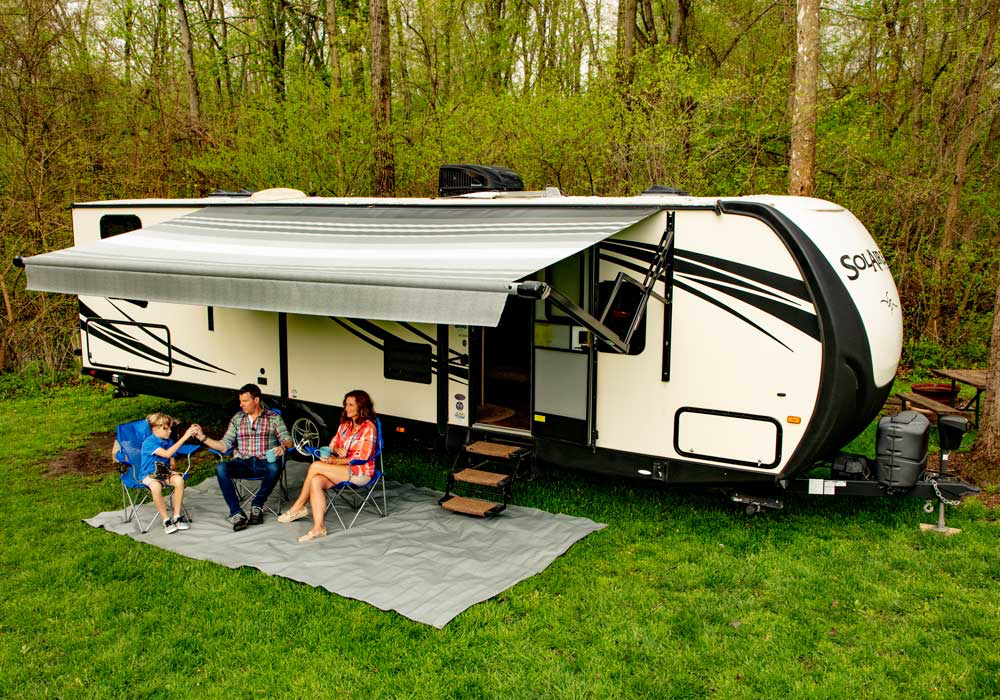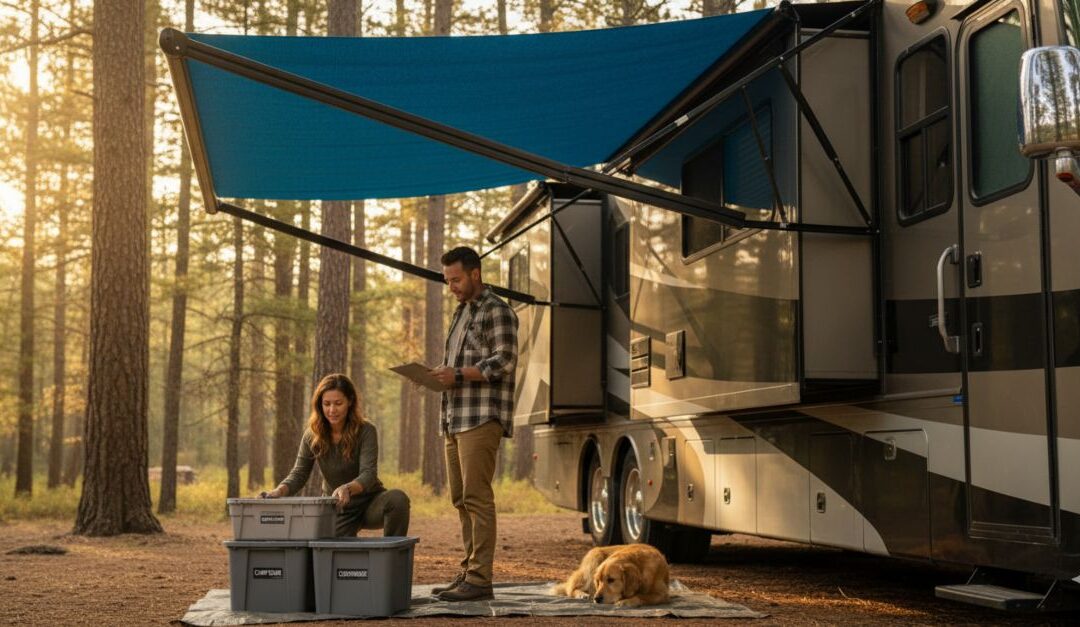Setting out on the open road should feel like the beginning of an unforgettable adventure, not a disorganized scramble. Whether you are a first-time RVer or a seasoned traveler, having a dependable RV checklist is the easiest way to stay prepared, organized, and stress-free. From safety checks before departure to
RV accessories, packing essentials, and setting up camp, this guide covers everything you need. No matter what vehicle you roam in, this checklist has everything you need for a smooth and comfortable ride.
RV Pre-Departure Checklist (Safety & Prep)
Your journey starts long before the wheels roll. A proper RV pre-departure checklist helps you catch issues before they become problems and ensures both your vehicle and your home are secure.
Exterior Checks
Before hitting the highway, give the outside of your RV a thorough once-over. These checks will help protect you from roadside surprises and costly breakdowns.
- Tires: Inspect pressure, tread, and lug nuts
- Propane: Verify tanks are filled and valves are secure
- Lights: Test headlights, taillights, and turn signals
- Fluids: Top off oil, coolant, windshield wiper fluid, and brake fluid
- Hoses: Check for leaks, cracks, or wear before you roll
Interior Checks
A safe ride starts inside, too. Stow items and ensure the cabinet latches are secure to prevent rattling, breaking, or shifting while you travel.
- Cabinets: Make sure latches are secure so nothing shifts in transit
- Appliances: Turn off stove burners and unplug small devices
- Windows: Close and lock to prevent rattling
- Loose Items: Stow away décor, small electronics, and tools
Travel Trailer & Camper Pre-Trip Checklist
If you are towing a camper or trailer, double-check the connections to ensure everything remains stable and safe on the road. It’s especially important to ensure that your brake lights and blinkers are functioning properly.
- Confirm tow hitch connection, safety chains, and trailer brake wiring
- Double-check tongue weight and load distribution for stability
Home Prep Before You Leave
Don’t forget about the home base you’re leaving behind. These steps keep things safe and stress-free while you’re away.
- Mail: Hold at the post office or ask a neighbor to collect
- Bills: Schedule auto pay or pay ahead of time
- Security: Lock doors, set alarms, and set lights on timers
- House Check: Unplug appliances, adjust thermostat, and secure outdoor spaces
- Download or update apps: If you use smart lights, locks or thermostats, make sure your apps are updated so you can keep tabs on your home systems on the road.
RV Packing List (What to Bring on Every Trip)
Packing with a plan makes the difference between a trip filled with comfort and one weighed down by stress and missing essentials. Use this RV packing list to stay ready for every adventure.
Kitchen & Food Essentials
Meals on the road taste better when you’re well prepared. Pack versatile items that save space and make cooking and clean up simple.
- Cookware: Compact pots, pans, and a collapsible strainer
- Storage: Reusable containers and zip bags
- Meals: Pre-prepped meals save time and space
- Clean up: Wash bins, dish soap, sponges, and drying racks are helpful if you need to do dishes outside of your vehicle.
Bedroom & Bathroom
Your RV should feel like a home away from home. Don’t forget to bring comfortable bedding and health essentials.
- Bedding: Sheets, blankets, and pillows
- Towels: Quick-dry towels and washcloths
- Toiletries: Travel-sized shampoo, soap, and toothbrushes
Clothing & Personal Items
In Colorado, we have a saying, “If you don’t like the weather, wait five minutes and it will change.” Be ready for any weather you may encounter by packing clothes and accessories that make travel easier in every condition.
- Weather appropriate layers for warm days and cool nights
- Electronics, chargers, and backup batteries
- Documents: ID, insurance papers, and roadside assistance info
Outdoor & Camping Gear
The best part of RV life is outdoor living. Bring along gear that transforms your campsite into a comfortable retreat, and allows you to get out and enjoy nature.
- Camping chairs and an awning mat
- Portable grill and cooking utensils
- Flashlights, lanterns, and extra batteries
- Sports equipment like bikes, fishing poles, or kayaks
Pet & Kid-Friendly Additions
Bringing the family along for the ride? Keep kids and pets safe and happy with these extra items.
- Toys, games, and comfort items
- Leashes, pet bowls, and travel crates
- Safety items like life jackets, helmets, or child seats
RV Setup Checklist at the Campground (Arrival)
When you arrive at your campsite or stopping point, follow this RV camping list to get set up quickly and safely.
Parking & Leveling Your RV
Start with stability. Leveling your RV with blocks and wheel stops ensures your vehicle remains steady and your appliances function properly.
- Choose a flat site, use leveling blocks, and chock your wheels
Hookups
The great thing about RV travelling is connecting to water and electricity. Make sure you have the proper cords, lines, and hookups you need.
- Water: Connect the hose and pressure regulator
- Electric: Hook up a surge protector before plugging in
- Sewer: Attach hoses securely and check for leaks
Extending Slide-Outs & Awnings
Slideouts and awnings expand your living space and give you room to breathe. Bring your user manual and maintenance tools to ensure your slideouts are fully functional and safe.
- Extend slideouts fully and ensure seals are tight
- Deploy awnings for shade and comfort, and secure them with tie downs and canopy clamps
Outdoor Living Space Setup
RV travel is all about comfort on the road. Bring camping chairs, shades and lights to personalize your outdoor area for relaxation and recreation.
RV Departure Checklist
Ready to head home? Follow this quick camper checklist to make packing up hassle-free and leave no trace.
Interior Tear-Down
Tidy and secure the inside so everything is safe on the move. And, yes we mean everything. That set of spices in the galley cabinet? The refrigerator door? Make sure they are locked and secured so you don’t arrive home to a mess of spices and food strewn about the RV (are we speaking from experience here…yes).
- Secure loose items
- Shut off appliances and electronics
Exterior Tear-Down
Disconnect and pack up in the right order for an easy, safe departure.
- Disconnect hookups in reverse order: sewer, electric, then water
- Pack up gear and outdoor equipment
- Retract awnings and slideouts fully
Must-Have RV Gear & Accessories
Having the right accessories can take your RV lifestyle from good to great. These items deliver safety, comfort, and convenience.
Safety Equipment
Protect yourself, your rig, and your travel companions with these safety essentials.
- Surge Protector
- Water Filter
- Leveling Blocks and wheel stops
- Road flares or reflective cones
Comfort Items
Be cozy and comfortable with these additions.
- Camping chairs
- Cozy robe or blanket
- Outdoor rugs
- Portable grill – be sure to check campsite rules and regulations before using a portable grill
- Explore our guide to the best RV accessories for more ideas
Tech & Tools
Stay connected, charged, and equipped for adventure. These travel accessories will keep you informed and help you stay in communication if you’re lost, injured, or need roadside assistance.
- GPS
- Power Banks
- Solar Panels for off-grid charging
RV Checklist: Your Seasonal Go-To
Each season comes with unique needs. Adjust your RV checklist so you’re always comfortable and prepared.
Summer RV Checklist
Stay cool, dry, and make the most of the sunshine.
- Cooling: fans, shades, and misters
- Outdoor Gear
- Insect Protection
Winter RV Checklist
Cold weather requires extra preparation. These essentials keep you warm and safe.
- Heating: additional blankets, space heaters, or heat packets
- Insulation
- Snow Gear: pants, jacket, hat, gloves, wool socks, and waterproof boots
Boondocking and Off-Grid Checklist
Heading off-grid? Bring extra resources to stay comfortable, self-sufficient, and safe.
- Solar
- Generators
- Water and food storage
- Extra propane
Emergency Prep & Roadside Assistance
Even the best prepared trips can hit a bump in the road. Bring these emergency items with you on every adventure.
Building an RV Emergency Kit
A well-stocked kit means you can handle surprises without panic. Ensure you have all the necessary essentials and supplies to reach the nearest hospital or other aid if needed.
- First aid supplies
- Jumper cables
- Flares
- Duct tape
- Multi tool
Roadside Assistance & Helpful Numbers
Have your backup plan ready so you are never stranded without support.
- Keep your insurance, towing, and roadside provider contact info handy
- Carry spare fuses and review available replacement parts before leaving home
Hit the Road with Carefree
Every great trip deserves the comfort and confidence that comes from the right gear. Carefree products are designed to elevate every stop along your journey with dependable performance, intuitive features, and industry-leading durability. From awnings and canopies to LED lighting, mats, and privacy accessories, our shade solutions make outdoor living effortless and enjoyable.
Whether you are planning a weekend getaway or a cross-country adventure, explore our collection of RV accessories built to last and trusted by travelers everywhere. Equip your RV with Carefree products and experience a new level of comfort, shade, and style on the road.
FAQs: RV Camping Checklist
What are RV must-haves?
Must-have RV gear includes safety items like a surge protector and leveling blocks, comfort gear like chairs and outdoor rugs, and essentials like cookware, bedding, and
outdoor lights.
How do I make my own RV checklist?
Start with this master guide and adapt it to your rig, travel style, and season. Divide your RV camping checklist into pre-trip, packing, arrival, and departure categories.
What is the rule of 3 for RVing?
Many RVers follow the 3-3-3 rule: drive no more than 300 miles in a day, arrive by 3 p.m., and stay at least 3 days to avoid burnout.
Do I need different RV checklists for long trips vs. weekend getaways?
Yes. Weekend trips may only require the basics, while extended travel calls for expanded food storage, more clothing, and additional gear for comfort and safety.

